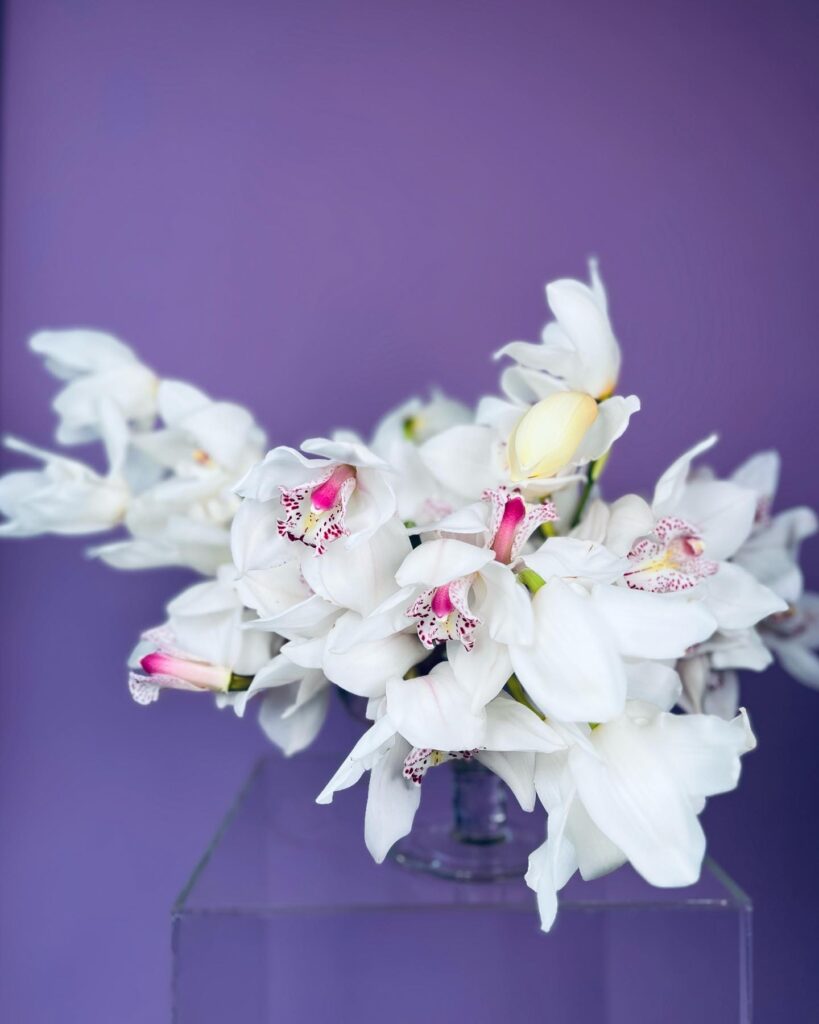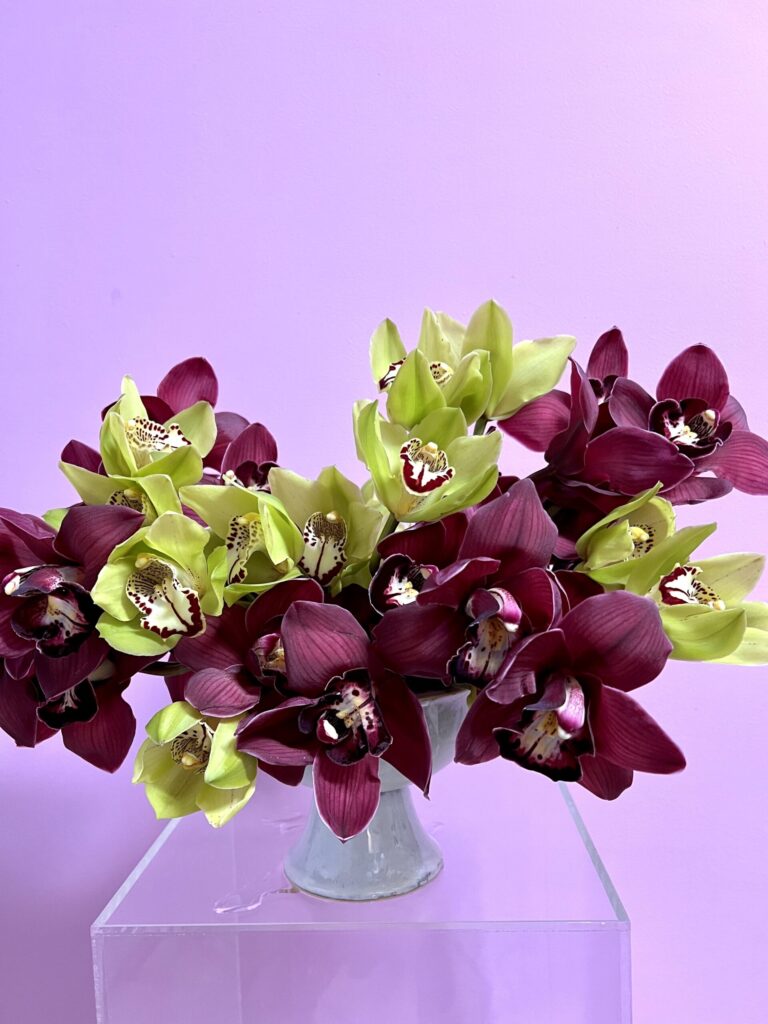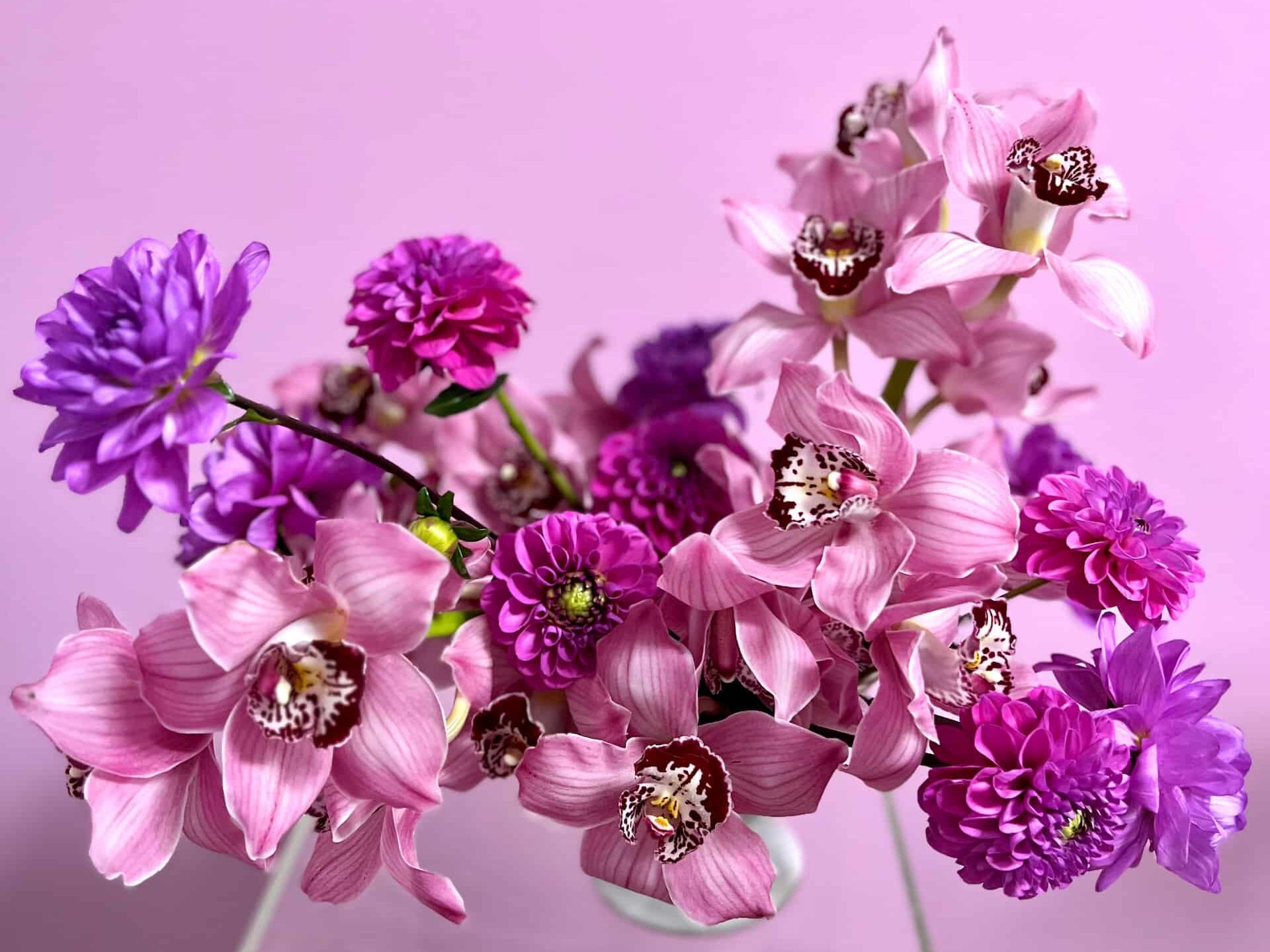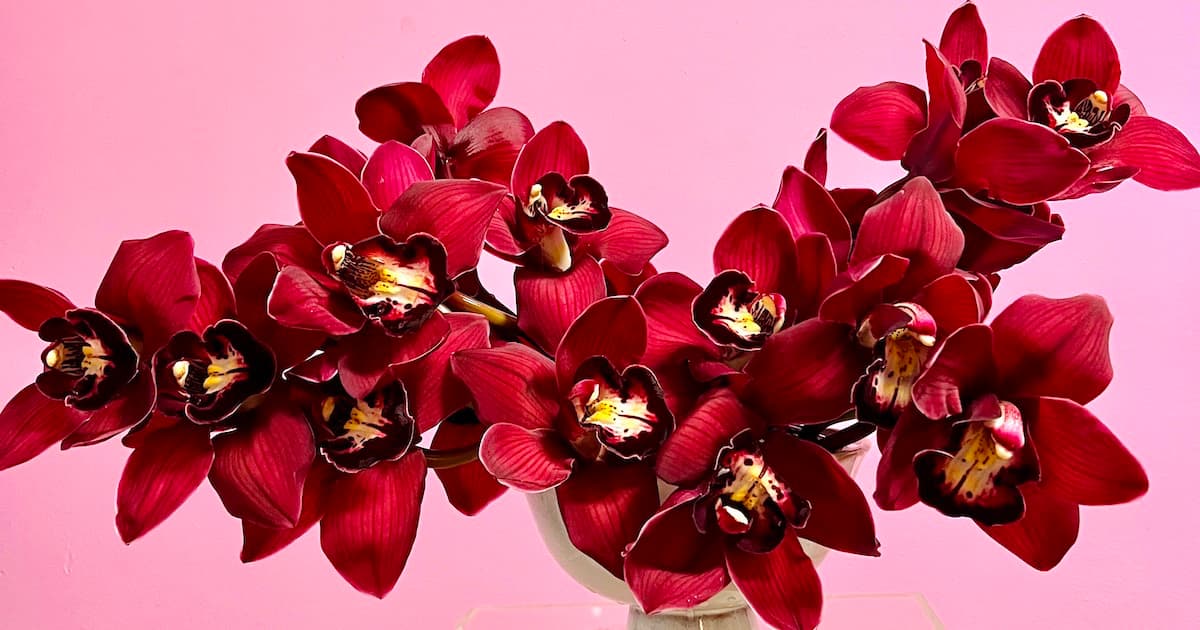Orchids: The Beauty and Magic of 25,000 Species
Whether you are a seasoned orchid enthusiast or are just beginning to explore the world of orchids (I’m somewhere in the middle), this guide will provide you with a comprehensive overview of the world’s most captivating and mesmerizing flowers, with a dive into their distinctive biology, ecology, and cultural significance.
The signature flower of Storybook Floral is the Cymbidium Orchid. For so many reasons, we call it our Dream Flower. Look for my next post where I’ll take a close look at this incredible species of Orchidaceae with you.
Table Of Contents
- A Brief History of Orchids
- The Structure and Characteristics of Orchids
- The Orchidaceae Family
- Caring for Orchids
- Orchid Resources

A Brief History of Orchids
Orchids are one of the most diverse groups of flowering plants, with over 25,000 species and 100,000 hybrid cultivars. These exotic and delicate flowers have captured the imagination of people for centuries, inspiring artists, botanists, gardeners, you and me alike. We yearn for them because of their beauty and unique characteristics. Have you ever noticed that you feel safe, protected, and curious when you’re near an orchid? Each one is a vibrational masterpiece.
Orchids can be found in almost every part of the world, from tropical rainforests to temperate woodlands. Orchids are best known for the stunning and intricate faces suggested by their blooms, which have captivated people for centuries and even sparked Orchid Fevers. Today, they are still widely cultivated for their beauty and are regarded as one of the most exotic and elegant flowers in existence.
In addition to their beauty and diversity, orchids also have important cultural and historical significance. Over thousands of years across many cultures, they’ve played a significant role in the folklore and mythology of diverse societies. Orchids were first documented by ancient Greeks and Romans who knew that they had special properties.
Orchids also have a medicinal history. In the early days of cultivation, orchids were primarily grown for their medicinal properties, and it wasn’t until the 19th century that they became popular as ornamental plants. There seems to be a cross-cultural agreement that orchids symbolize wealth, beauty, love, and undeniable luxury. Some religious ceremonies even depend on them.
Right this moment, orchids are still highly valued and are a major part of the global horticulture industry. They are exquisite ornamental plants and are also used in perfumes, cosmetics, and traditional medicine. Whether you prefer the bold, striking blooms of the Cattleya or the delicate, fragrant flowers of the Phalaenopsis, there is an orchid that is sure to delight you.

The Structure and Characteristics of Orchids
One of the key reasons why orchids are so fascinating is their incredible diversity. They come in a wide range of shapes, sizes, and colors, with some species having petals that are less than a millimeter in length, and others having flowers that can grow up to a foot in diameter. In addition to their size, orchids are known for their intricate patterns, bold colors, and delicate fragrances, which make them a popular choice for cut flower arrangements and indoor gardens.
Orchids are typically characterized by their large, showy blooms and distinctive flower shapes. Each species has its own unique set of features, ranging from the delicate, spidery petals of the Cymbidium, to the bold, spotted flowers of the Cattleya. The flowers are also known for their long lifespan, lasting up to several months for some species..
These beautiful flowers are also known for their remarkable biology. They belong to the monocot group of plants, which also include lilies and grasses. Unlike other flowering plants, orchids have evolved a unique reproductive strategy that allows them to reproduce both sexually and asexually.
They rely on a symbiotic relationship with fungi in order to grow and reproduce. This relationship, known as mycorrhiza, allows orchids to obtain nutrients from the soil and helps to ensure that the plant will have enough resources to produce its large, showy flowers. This gives them a competitive advantage in their natural habitats, as they are able to produce offspring even when conditions are unfavorable for sexual reproduction.
Incredibly, orchids are found all over the world, from the Arctic tundra to tropical rainforests. They have adapted to a wide range of environmental conditions and can be found growing in soil, on trees, and even in water. Some species of orchids are epiphytic, meaning they grow on other plants without actually parasitizing them. This lets them take advantage of the sunlight and nutrients available in their host plant’s environment while avoiding competition for resources. Instead, they absorb moisture and nutrients from the air and surrounding organic matter. This allows them to grow in areas where other plants may not be able to survive, such as on the sides of trees or in rocky crevices.
In addition to their unique reproductive strategies, orchids are also known for their innovative methods of attracting pollinators. Most orchids have three sepals and three petals that form a cup-like structure, known as the lip. The lip is usually the most distinctive part of the orchid flower and is often brightly colored or intricately shaped to attract pollinators.
Some species of orchids produce fragrances that mimic the pheromones of female insects, while others have flowers that look and act like female insects. This allows the plant to attract male insects, which are then tricked into transferring pollen from one flower to another, thereby ensuring that the plant will produce seed.

The Orchidaceae Family
The Orchidaceae family is one of the largest and most diverse plant families in the world, with over 25,000 species and 100,000 hybrids. The family is characterized by its unique flowers, which are known for their intricate designs and unusual shapes.
The taxonomy of the Orchidaceae family is divided into several subfamilies, each with its own unique characteristics and differences. The following is a brief overview of the main subfamilies within the Orchidaceae family, along with a description of their distinct differences.
The Apostasioideae subfamily is one of the smallest subfamilies within the Orchidaceae family, with only a handful of species. The plants in this subfamily are known for their simple, undivided leaves and their small, inconspicuous flowers.
The Cypripedioideae subfamily is perhaps the most well-known subfamily within the Orchidaceae family and is characterized by its large, showy flowers and its distinctive lip. The lip is often brightly colored and is often the main focus of the flower. The Cypripedioideae subfamily is also known for its terrestrial habit, with many species growing in the ground rather than on other plants.
The Epidendroideae subfamily is one of the largest subfamilies within the Orchidaceae family, with over 15,000 species. The plants in this subfamily are known for their highly variable flowers, with many species having large, showy blooms. The Epidendroideae subfamily is also characterized by its epiphytic habit, with many species growing on other plants.
The Orchidoideae subfamily is characterized by its small, simple flowers, which are often arranged in spikes or spikes. The leaves in this subfamily are often fleshy and the plants are often terrestrial.
The Vanilloideae subfamily is characterized by its large, showy flowers and its distinctive lip. The lip is often brightly colored and is often the main focus of the flower. The Vanilloideae subfamily is also known for its terrestrial habit, with many species growing in the ground rather than on other plants.
In addition to the distinct differences between the subfamilies within the Orchidaceae family, there are also differences between species within each subfamily. For example, some species within the Cypripedioideae subfamily are known for their large, showy flowers, while others are known for their more modest blooms. Within the Epidendroideae subfamily, some species have fragrant flowers, while others have no fragrance at all.
One of the most important factors that contribute to the diversity of the Orchidaceae family is its widespread distribution. Orchids can be found in nearly every part of the world, from the tropical rainforests of South America to the arid deserts of Africa. This widespread distribution has allowed the family to evolve and adapt to a wide range of environmental conditions, which has in turn contributed to its remarkable diversity.
Another important factor that contributes to the diversity of the Orchidaceae family is its symbiotic relationship with fungi. Most orchids have a mutualistic relationship with fungi, where the fungi provide the orchids with essential nutrients, and the orchids provide the fungi with a place to live. This relationship allows orchids to grow in environments where other plants would not be able to survive, and has also allowed them to evolve unique adaptations to their habitats.

Caring for Orchids
Despite their incredible beauty and diversity, orchids are often misunderstood or intimidating. There’s a misconception that orchids are difficult to care for and require specialized growing conditions. In reality, many species of orchids are relatively easy to care for and can be grown successfully by anyone with a basic understanding of their needs. This means you can indeed successfully grow them at home.
To start growing orchids, you will need to understand the basic needs of the species you have chosen. Some orchids require bright, indirect sunlight, while others prefer low-light conditions. The most commonly available orchid is the Phalaenopsis orchid (sometimes called a Moth orchid). This orchid does well in most indoor rooms with an available window. Just add 3-5 ice cubes once a week and enjoy weeks of blooms. Other orchid species need more or less water and light. A simple internet search or consult with your local orchid grower will help you choose the right orchid for your space.
If you are planting or re-planting an orchid, make sure to the proper growing medium for your orchids, as well as provide receive the correct amount of moisture and nutrients. Orchids are true air plants, and their roots need exposure to it.
Most orchids are epiphytes, which means that they grow on other plants but do not rely on them for nutrients. This means that they require a well-draining soil mix, bright but indirect light, and regular but minimal watering. In addition, orchids grow and flower best with a regular feeding program, which should include a balanced fertilizer and occasional doses of organic material. If you can meet the orchid grower, you can get a great look at the science behind the growth.
Another important aspect of growing orchids is understanding their flowering patterns. Most orchids are seasonal bloomers, which means that they will only produce flowers at certain times of the year. In order to encourage blooming, it is important to provide the plant with what it needs. In addition, some species of orchids may also require a period of cooling and rest in order to produce flowers, so it is important to be familiar with the specific requirements of each species in order to keep them healthy and thriving.
For example, the phalaenopsis orchid mentioned above will be dormant for parts of the year. When it finishes blooming, cut the stem from its origin point with a clean knife. Let it live in the proper area, continue your watering a feeding schedule, and look forward to another bloom once or even twice a year.
Here are some general guidelines to help you care for your orchids:
Light: Most orchids prefer bright, indirect light, but it is important to protect them from direct sunlight, which can burn the leaves and flowers.
Water: Orchids prefer to be kept evenly moist, but not wet. Overwatering can lead to root rot, so it is important to allow the potting mix to dry out slightly between waterings.
Humidity: Many orchids come from tropical regions and prefer high humidity levels, so it is important to provide them with adequate moisture in the air.
Temperature: Most orchids prefer temperatures between 60 and 80 degrees Fahrenheit, with a few species requiring cooler temperatures.
Potting Mix: Orchids require a well-draining potting mix that is designed specifically for epiphytes. Many garden centers and online retailers sell orchid potting mixes that are ideal for growing these plants.
Fertilizer: Orchids benefit from regular feeding with a balanced fertilizer, but it is important to follow the recommended guidelines for each species, as some may require less frequent feeding.
Repotting: Most orchids benefit from being repotted every two to three years, as this gives them a fresh potting mix and more room for their roots to grow.
Pests and Diseases: Orchids can be susceptible to pests such as scale insects and mealybugs, as well as fungal and bacterial diseases. If you notice any signs of pest or disease problems, it is important to address them promptly to prevent them from spreading to other plants
Orchids are an incredibly rewarding group of plants to grow. With their stunning beauty, intricate patterns, and fascinating reproductive strategies, orchids are sure to captivate and inspire you for years to come. Growing orchids can be a rewarding hobby because they are delicate plants that require patience and care.
There are many resources available to help you get started. From online forums and discussion groups to books and magazines, there is a wealth of information and advice available for anyone interested in growing. So why not start exploring the world of orchids today, and discover the beauty and wonder of these incredible blooms for yourself?

Orchid Resources
Orchid Societies
- American Orchid Society
- San Diego County Orchid Society
- San Diego Cymbidium Society
- Palomar Orchid Society

